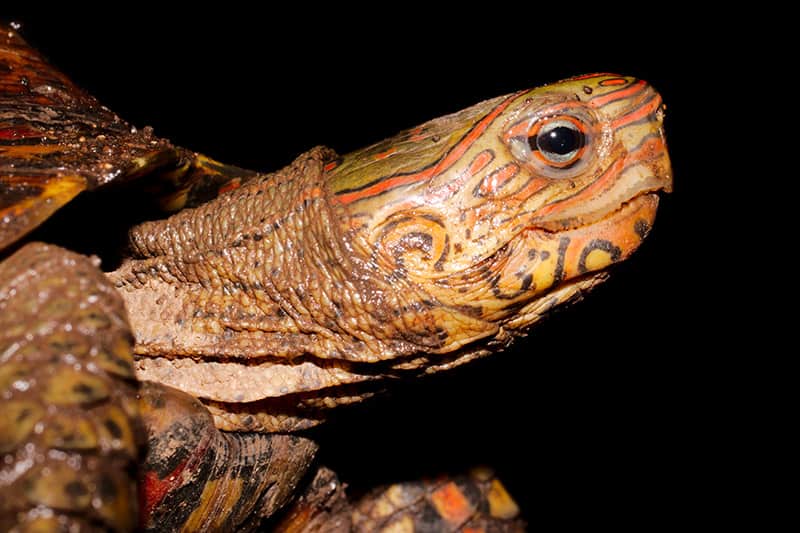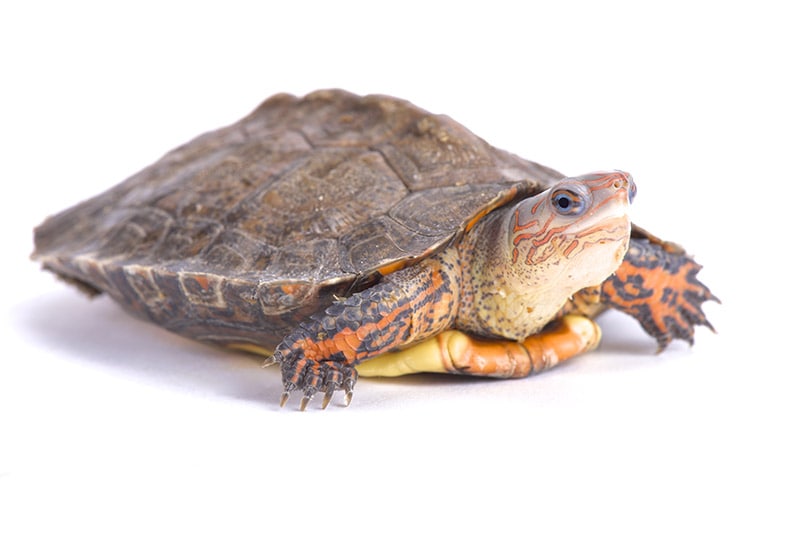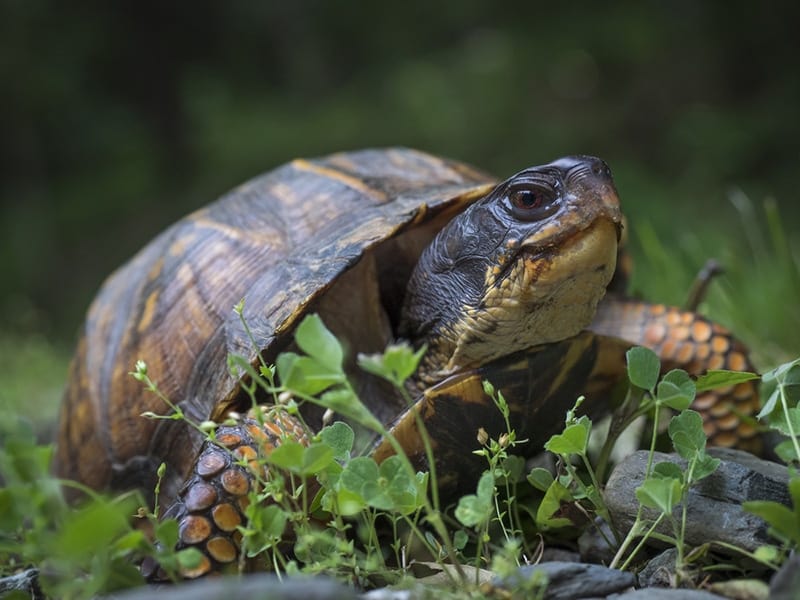Even a well-acclimated Ornate Wood Turtle can be quite shy when first approached, but it will quickly peek back out looking for a snack!
The Ornate Wood Turtle, is one of the most common wood turtles seen in the pet trade. They have been imported in large numbers in recent years. They can be quite beautiful and brightly colored, especially those from northern Costa Rica. These specimens will be covered with swirls of orange and yellow along with black ocelli (eyespots). Due to their variety of form along with beautiful colors and patterning, these and all the wood turtles are likely candidates for captive breeding programs.
The Central American Wood Turtles are an appealing group of turtles. They are great to keep and will soon become tame. They are a manageable size for most keepers and have proven to be extremely hardy once established. Wanderers on land and somewhat shy, they should be offered plenty of shelter in the form of cork bark tubes or piles of dry leaves. They will often race under a shelter at the approach of their keeper, then will cautiously reappear to see if any food has been offered.
- For more information see: Selecting and Caring for Your Turtle or Tortoise
Scientific Classification
| Kingdom: | Animalia |
| Phylum: | Chordata |
| Class: | Reptilia |
| Order: | Testudines |
| Family: | Geoemydidae |
| Genus: | Rhinoclemmys |
| Species: | pulcherrima |
Distribution
The Ornate Wood Turtle R. p. manni, or Central American Wood Turtle, is found from Southern Nicaragua to northern Costa Rica. This turtle is one of the four subspecies of Painted Wood Turtles Rhinoclemmys pulcherrima which were described by Gray in 1855. With large numbers having been imported in recent years, the Ornate Wood Turtle is the most common of the Rhinoclemmys species seen in the pet trade.
In all there are eight species of Wood Turtles (and several subspecies) in the Rhinoclemmys genus. They are found from Mexico and throughout Central America.
- Painted Wood Turtles: Rhinoclemmys pulcherrima pulcherrima
Oaxacan or Honduran Wood Turtle Rhinoclemmys pulcherrima incisa
Ornate Wood Turtle Rhinoclemmys pulcherrima manni
Rhinoclemmys pulcherrima rogerbarbouri - Brown Wood Turtle Rhinoclemmys annulata
- Furrowed Wood Turtle Rhinoclemmys areolata
- Diadem Wood Turtle Rhinoclemmys diademata
- Black Wood Turtle Rhinoclemmys funerea
- Columbian Wood Turtle Rhinoclemmys melanosterna
- Large-nosed Wood Turtle Rhinoclemmys nasuta
- Spot-legged Wood Turtles:
Rhinoclemmys punctularia punctularia
Rhinoclemmys punctularia flammigera
The Mexican Spotted Wood Turtles Rhinoclemmys rubida were classified in the Rhinoclemmys genus, but some sources now place them in the genus Chelopus.

Status
These turtles are not listed on the IUCN Red List.
Description
The Ornate Wood Turtle is quite variable in color. Those from southern Nicaragua can be quite bland while those from northern Costa Rica are brightly colored. Some of the beautiful specimens are covered with swirls of orange and yellow with varying degrees of black ocelli (eyespots) on the carapace and with a wash of pink or red on the plastron. The adult Ornate Wood Turtle grows to 8″ (20 cm) in length while some of the other species get bigger, reaching up to 14″ (35 cm) in the larger Black Wood Turtle, R. funerea.
Care and Feeding
Wood turtles have a wide range of feeding habits, but most species are omnivorous. Species such as the Ornate Wood Turtle will eat earthworms, redworms, crickets, and even mice. Once or twice a week these turtles also eagerly consume a salad consisting of chopped and shredded fruits and vegetables. They are especially fond of kale, zucchini, squash, mango, cantaloupe, banana, and apple. Dust this salad liberally on every third or fourth feeding with a high-quality calcium and multivitamin powder mixture.
Care must be taken that these, and any turtles, are not released into a wild habitat. The reasons are many. The introduction of non-native species can lead to the introduction of diseases and can lead to hybridization of introduced and native species. In addition, many turtles raised in captivity and released into wild situations are confused, unable to cope with extreme weather changes, and many surely fall prey quite quickly to the wary predators they may encounter.

Environment
The Ornate Wood Turtle is semi-terrestrial. An enclosure for wood turtles closely mirrors a slightly drier version of an enclosure for marshy pond turtles, such as those of the Clemmys genera.
A small breeding group of wood turtles, two males and four females, can be properly maintained in an 8′ x 8′ area outside or in a medium to large tub or stock tank inside. Substrate in indoor enclosures consists of a three layer system: a layer of pea gravel followed by a 10-12″ layer of ½ dampened sand and ½ peat moss, followed by a thin layer of cypress mulch.
For the more terrestrial wood turtles, such as the Ornate Wood Turtle, provide a cat litter pan, paint tray, or cement mixing tub of fresh water. Change the water every few days or when needed. Include sheets of bark and piles of hay or leaves to add secure hiding places on land. Provide UVB-emitting bulbs placed in shop light fixtures overhead and a 100-watt bulb in a clamp-type fixture over each basking spot.
Handling
Captive-hatched specimens, as always, are the best to keep as pets and most will become so docile that they can easily be fed by hand. These and all aquatic turtles should be considered wonderful display animals and not pets that are easily held.
Breeding
Some wood turtle species including the Ornate Wood Turtle R. p. manni and Black Wood Turtle R. funerea have proven easy to breed. Literature suggests that most of the other Rhinoclemmys should also be fairly easy to breed in captivity. Most wood turtles will require a period of hibernation in the mild 60° to 65° F (16° to 18°C) range to inspire courtship and mating. Successful breeders cool their adults in a monitored indoor situation for between 45 to 60 days during the cooler months. Rain, both natural and man-made, is an important trigger for courtship and breeding in these humidity-loving species.
The Ornate Wood Turtle has proven to be quite prolific in captivity, laying 2-3 clutches of four eggs each year. The babies can be set up in a 20-gallon aquarium with damp peat moss and sand as a substrate and with a layer of damp sphagnum moss, leaf litter, and cypress mulch on top. You can offer warmth from below with a heating pad on the low setting and from above with a 60-watt incandescent bulb in a clamp-type fixture. UVB-emitting bulbs are placed in an aquarium fixture or a shop light fixture above the enclosure.
The babies are hardy and grow quickly when offered a healthy diet featuring a variety of feeder insects such as redworms, mealworms, crickets, and waxworms, along with fruit and soaked commercial pellets offered soaked in a flat dish or tossed into the aquatic portion of the enclosure.

Ailments / Health Problems
Since most Ornate Wood Turtles, as well as the other Rhinoclemmys species have only been available as imported specimens, you can expect them to be harboring any number of parasites, especially roundworms. They have proven easy to “clean up” with Panacur® and Flagyl®. The resulting parasite-free turtles quickly put on weight and once acclimated well, tend to become quite sociable, even taking their favorite food (bananas) out of their keeper’s fingers.
Rhinoclemmys often arrive to importers with some scrapes and cuts, the most severe problems being shell rot and missing scutes. These maladies and injuries seem not to affect them too much and they clean up well with a Betadine® scrub and 3-4 applications of Silvadene® cream when kept in a warm, well-planted enclosure.
Availability
Ornate Wood Turtles are commonly imported and there are also captive bred specimens occasionally available. Captive-bred make the best pets and are less prone to harboring parasites. These turtles can be purchased from better pet stores, from breeders at the larger reptile shows across the country, and on-line.
Featured Image Credit: Brandt Bolding, Shutterstock
